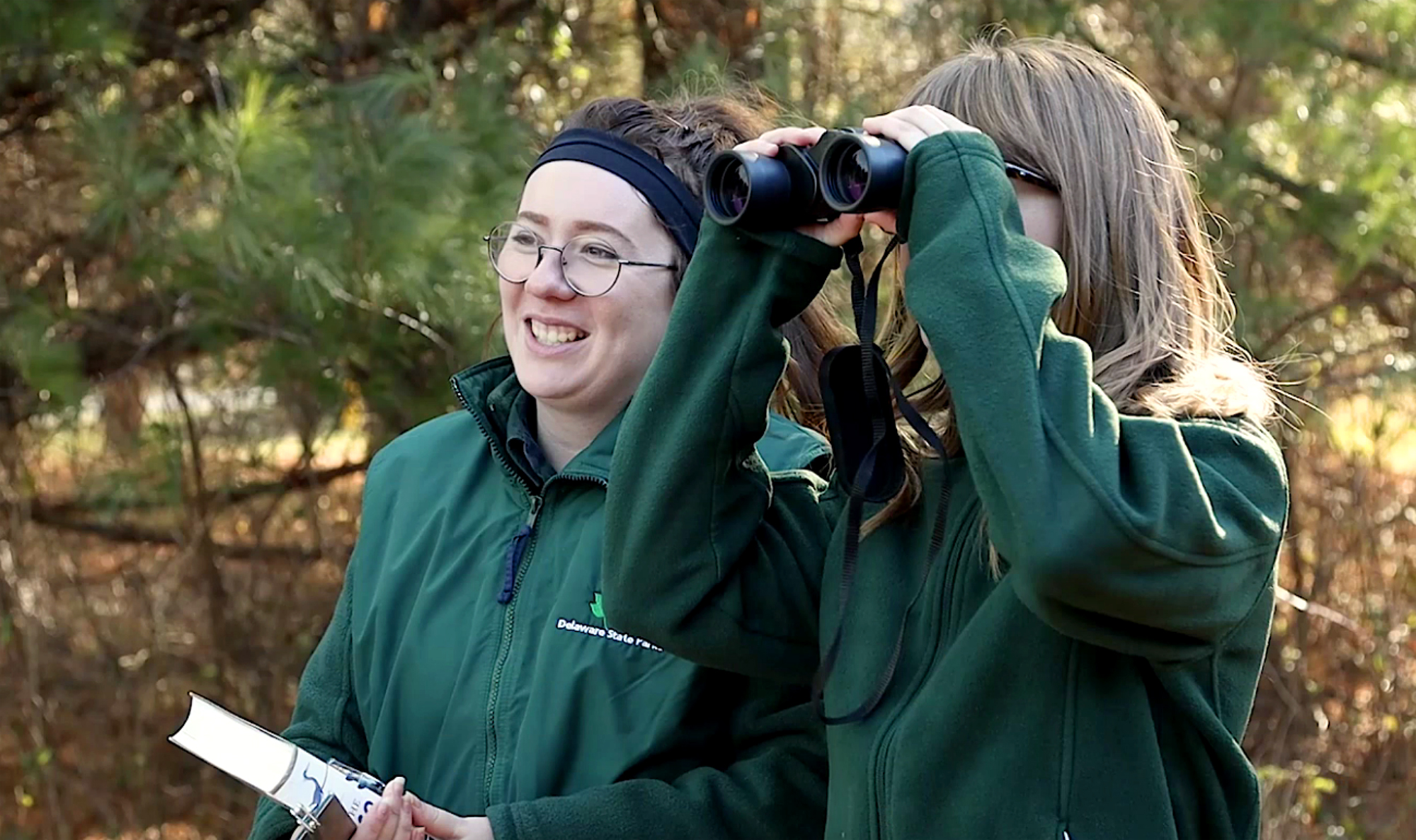
April 17, 2020
By Sam Sobel, Interpretive Programs Manager at Lums Pond State Park and Katelyn Hartnett, Manager of Volunteers at Lums Pond State Park
Introduction
Eastern Bluebirds are an eye-catching species of bird that can be found in Lums Pond State Park and throughout Delaware. Their preferred habitats are open grasslands around tree lines, agricultural lands, and open forest. They are cavity nesters, meaning they make nests in sheltered cavities like old woodpecker holes found in trees. Eastern Bluebird populations were threatened in the early 20th century due to the introduction of invasive species, like the starling and house sparrow, who would compete with bluebirds for nest cavity sites. Thanks to citizen science projects and local birding groups, nest boxes were created and used to provide more nesting sites for the bluebirds. As a result of these efforts, the bluebird population is stable and no longer a species of concern.

We hope to continue that tradition of bluebird monitoring here at Lums Pond as it aligns with our goal of bringing the public closer to nature in our parks.
Where the Journey Began
To start the process of revitalizing the Lums Pond Nest box program park staff first needed to evaluate the nest boxes already in the park. To accomplish this, Katelyn the Volunteer Manager enlisted the help of two local Boy Scout of America troops, Troop 92 and Troop 336. The volunteer Scouts assisted Katelyn in identifying locations of all nest boxes within the park, evaluating their condition, and cleaning out the old nests inside them. Most of the boxes were damaged by weather, missing predator guards, and were not at proper locations for bluebirds. This information helped park naturalists get an up to date listing of boxes within the park and start the process of determining whether to remove or replace them.

Nest Boxes and Monitoring:
For resources on setting up the boxes and monitoring we used research and guidelines set out by Nest Watch, which is a program run by the Cornell Lab of Ornithology (https://nestwatch.org/). Additionally, we consulted the guidelines from our Natural Resource Department in Delaware State Parks.
Nest Boxes:
After determining the old boxes were inadequate, the next step in the process was to create new nest boxes. A boy scout looking to complete a project to earn his Eagle Scout badge stepped up to the task and built fifteen new nest boxes for the park. Naturalist staff then moved forward with mapping out different locations in the park for the new boxes that would prioritize bluebird habitat and ease of access for volunteers. Using GPS points and a mapping program, the spots for the new boxes were mapped for future reference. This online documentation will ensure that future naturalists will have an up-to-date inventory on all the new boxes in the park. These new boxes were constructed using guidelines from Nest Watch and are designed to prevent predators and non-target bird species from accessing the nests. With help from the eagle scout and Boy Scout Troop 125, five of the brand-new boxes were installed this January. Pending the success of the first batch of new nest boxes, the remaining ten will be installed next year.

Monitoring:
Naturalists met with local birding organizations in Delaware to get advice and see how other agencies manage their boxes and volunteers. Using this advice and the help of the Nest Watch guidelines, we set up a monitoring schedule and manual that includes frequently asked questions and best monitoring practices. This, paired with a training before the start of the monitoring season, is our way of better protecting the birds and preparing our volunteers.

With the brand-new boxes in place, the only thing remaining was to gather a team of volunteers to assist with monitoring them for the upcoming Spring and Summer season. The volunteer manager and naturalist staff held an interest meeting explaining the project to potential volunteers and were able to create a team of five dedicated, bird-loving, volunteers. After being trained, the bluebird monitoring volunteer team started the monitoring season in the second week of March and will continue to monitor their boxes until August. We are already starting to see the appearance of blue bird eggs in several of our new nest boxes!

When we monitor the boxes, we are collecting data on our local bluebird population and behavior. We aim to share these observations during our programming to get members of the public of all ages interested in nature and engaged in the wellbeing of wildlife in our park. At the end of the season, we also share these numbers with the national Nest Watch database so our data can be used to better prepare management and conservation decisions on a national scale.
The Journey Continues…
Volunteers are critical and we would not be able to run a program like this without them. Monitoring can be a rewarding opportunity. As you watch a special process of life unfold, it brings you closer to nature and the park. The care and upkeep of these boxes depend on our volunteers. With more boxes planned to go in for next year we are looking out for new volunteers to join our team of Bluebird Monitors!

For more information on the Bluebird Monitoring program please email Samantha.Sobel@delaware.gov.
We would like to give a special thanks to those that helped kickstart this project:
- Naturalists: Lauren Barczak and Molly Williams
- Manager of Volunteers: Katelyn Hartnett
Interested in having your own bluebird box? For more information on Eastern Bluebird box construction and monitoring guidelines visit nestwatch.org.


